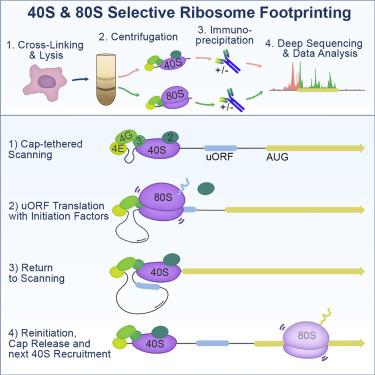Molecular Cell ( IF 14.5 ) Pub Date : 2020-06-25 , DOI: 10.1016/j.molcel.2020.06.005 Jonathan Bohlen 1 , Kai Fenzl 2 , Günter Kramer 3 , Bernd Bukau 3 , Aurelio A Teleman 1

|
Translation regulation occurs largely during the initiation phase. Here, we develop selective 40S footprinting to visualize initiating 40S ribosomes on endogenous mRNAs in vivo. This reveals the positions on mRNAs where initiation factors join the ribosome to act and where they leave. We discover that in most human cells, most scanning ribosomes remain attached to the 5′ cap. Consequently, only one ribosome scans a 5′ UTR at a time, and 5′ UTR length affects translation efficiency. We discover that eukaryotic initiation factor 3B (eIF3B,) eIF4G1, and eIF4E remain bound to 80S ribosomes as they begin translating, with a decay half-length of ∼12 codons. Hence, ribosomes retain these initiation factors while translating short upstream open reading frames (uORFs), providing an explanation for how ribosomes can reinitiate translation after uORFs in humans. This method will be of use for studying translation initiation mechanisms in vivo.
中文翻译:

选择性40S足迹揭示了人类细胞中的帽栓核糖体扫描。
翻译调节主要发生在启动阶段。在这里,我们开发选择性的40S足迹以可视化体内内源性mRNA上的起始40S核糖体。。这揭示了mRNA上起始因子加入核糖体起作用并离开的位置。我们发现,在大多数人类细胞中,大多数扫描核糖体仍附着在5'帽上。因此,一次只有一个核糖体扫描5'UTR,而5'UTR长度会影响翻译效率。我们发现,真核起始因子3B(eIF3B,)eIF4G1和eIF4E在开始翻译时仍与80S核糖体结合,衰变半长约为12个密码子。因此,核糖体在翻译短的上游开放阅读框(uORF)时保留了这些起始因子,从而为核糖体如何在人中发生uORF后重新启动翻译提供了解释。该方法将用于研究体内翻译起始机制。











































 京公网安备 11010802027423号
京公网安备 11010802027423号